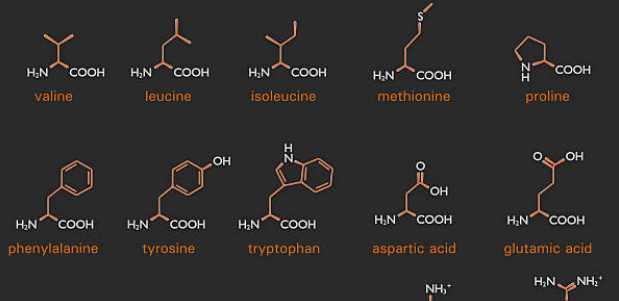What Are The Building Blocks Of Proteins

Proteins are one of the most important types of molecules that are required for life to exist as we know it. Proteins play numerous roles in the body, by being the building blocks, forming physical structures, catalyzing metabolic reactions, transporting molecules, and signaling between cells.

Amino Acids and the human body
The human body is thought to contain 50,000-100,000 different types of proteins, each of which is specialized to perform a specific function.
Amino acids are the basic building blocks of proteins. Amino acids are arranged into a polypeptide chain, which is a linear molecule found in proteins.
Some proteins are made up of just one polypeptide chain, while others are made up of multiple polypeptide chains that are bonded together. The function of a protein is determined by the order of amino acids and the 3-D geometry of the protein.
Most people are aware that their bodies are 60% water; however, did you know that protein account for 20% of your total body weight? Proteins work in your body can be likened to a construction crew.
They help your body's mechanical processes by transporting substances, constructing others, and converting energy.
Types of Amino Acids
Amino acids are the building blocks of proteins. Twenty of them are required for your body to function properly, as well as to build and repair itself.

What Are Essential Amino Acids?
Essential and non-essential amino acids are the two types of amino acids. These proteins are not produced by the human body, despite the fact that they are required for human survival. This means you'll have to get them from plant and animal protein sources.
The following are the essential amino acids:
- Phenylalanine
- Methionine
- Lysine
- Histidine
- Tryptophan
- Isoleucine
- Valine
- Leucine
- Threonine
Histidine technically belongs on the list of non-essential amino acids. However, because children's bodies do not produce enough histidine, they must obtain it through their diet.
Non-essential Amino Acids
Non-essential amino acids are those that our bodies can make on their own. The majority of them are made from glucose. They are, of course, present in the diet, in both plant and animal foods.
The difference between non-essential and essential amino acids is that essential amino acids must be obtained through food or supplement.
Among the non-essential amino acids are:
- Alanine
- Proline
- Arginine
- Glutamine
- Aspartic acid
- Asparagine
- Cysteine
- Glutamic
- Glycine
- Tyrosine
- Serine
What are the primary functions of proteins?
The only nutrient that can build, repair, and maintain body tissues is protein. It's critical to get enough protein in your diet on a daily basis.
A few of proteins' functions are listed below.
- Proteins aid in the regeneration and creation of DNA molecules, as well as the execution of complex processes.
- Digestive enzymes, which are primarily proteineous in nature, are responsible for digestion.
- Proteins are linked to the production of a variety of hormones that aid in the balancing of the body's components.
- Cells use receptors on their surfaces to communicate with other cells and the outside world. Proteins make up these receptors.
- Antibodies are a type of protein that the immune system uses to repair and heal the body after it has been exposed to foreign bacteria.
- These proteins act as chemical messengers, allowing cells, tissues, and organs to communicate with one another.
- Damaged cells must be repaired and dead cells must be replaced. Because proteins are the building blocks of every body cell, it's no surprise that the greatest demand for protein occurs during growth stages like childhood, adolescence, and pregnancy.
- Amino acids, which are small units required for tissue growth and repair, make up proteins. Proteins are necessary for the growth of skin, teeth, and bones.
- They also help to build and repair damaged tissue, as well as produce enzymes and hormones.
Requirements for Amino acid in the body
How can we ensure that we are eating enough amino acids to meet our bodies' needs?
The solution is surprisingly simple: we just need to consume a recommended amount of protein each day and a variety of whole foods.

Animal and Plant protein
Animal proteins are known as complete proteins because each serving contains all nine essential amino acids. But what about those of us who aren't meat-eaters? What options do we have?
Plant proteins, with the exception of quinoa and a few others, are naturally deficient in some essential amino acids, and thus are referred to as incomplete proteins.
You can easily obtain complete proteins by eating a varied diet of vegetables, grains, and legumes.
Incorporate a full-spectrum vegan protein powder into your diet as well. Try sprouted brown rice protein, which is naturally digestible, and contain the entire amino acid spectrum.
Make sure your diet is high in whole foods and plant life, no matter how you choose to nourish your body. As a result, you can rest assured that your body is getting a complete amino acid profile and is thus ready to thrive.
Author Bio
Writer comprises full-time and freelance writers that form an integral part of the Editorial team of Hubslides working on different stages of content writing and publishing with overall goals of enriching the readers' knowledge through research and publishing of quality content.
Article Comments
No Comments!
At present there are zero comments on this article.
Why not be the first to make a comment?
Similar Articles
Sponsor
Search Articles
Experts Column
Latest Articles
Featured Articles
Most Popular Articles












